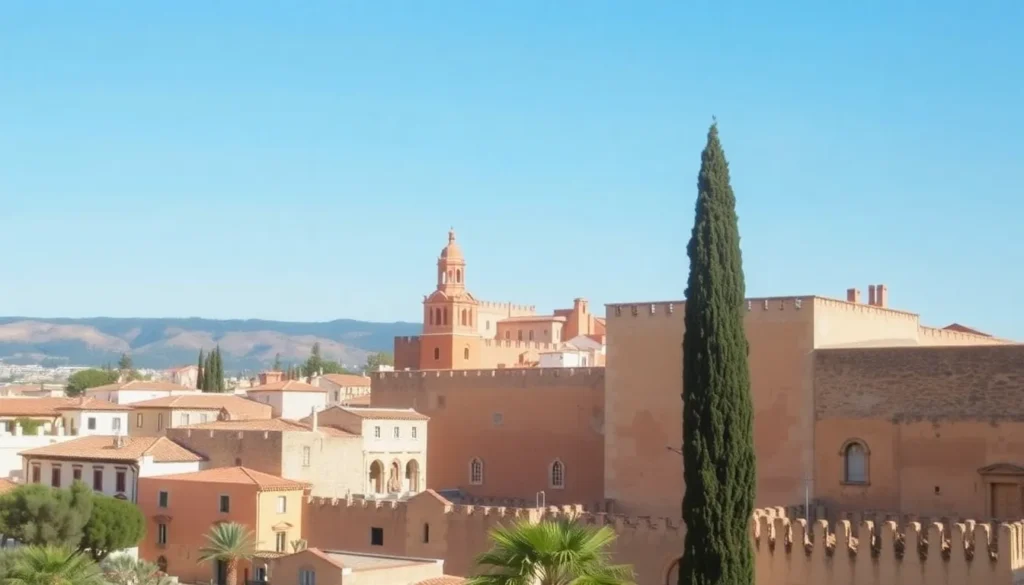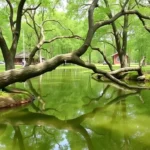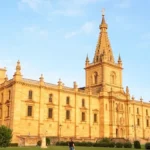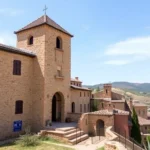15 Must-See Attractions and Activities in Baeza

- A Brief History of Baeza
- 1. Plaza del Pópulo: The Heart of Baeza
- 2. Arco de Villalar and Puerta de Jaén
- 3. Ancient Escribanías and Old Butcher Shop
- 4. Calle Conde Romanones: A Hidden Gem
- 5. Plaza de Santa María: The City’s Cultural Hub
- 6. Cathedral of the Nativity of Our Lady
- 7. Discovering the Cathedral’s Alleys
- 8. Scenic Views from the Paseo de las Murallas
- 9. Remnants of Towers and Fortifications
- 10. Palacio de Jabalquinto: A Gothic Marvel
- 11. Iglesia de Santa Cruz: A Rare Romanesque Gem
- 12. The Ancient University of Baeza
- 13. A Journey Through Antonio Machado’s Baeza
- 14. Paseo de la Constitución: The Local Meeting Spot
- 15. The Essence of Olive Oil in Baeza
- Where to Stay in Baeza
- Parking Options in Baeza
- Dining in Baeza
Planning a getaway to Baeza? This charming city, along with its close neighbor Úbeda, is a UNESCO World Heritage site renowned for its rich Renaissance heritage. Dive into this guide as we explore the top 15 must-see attractions and activities in Baeza, ensuring you make the most of your visit.
A Brief History of Baeza
Baeza's historical significance can be traced back to the Reconquista, a period when the Christian kingdoms fought to reclaim territory from Muslim rule. This region served as a strategic foothold for the Castilian advance. To solidify their control, it was common to grant lands or titles to influential nobles. In Baeza, two powerful families, the Benavides and the Carvajales, played pivotal roles in shaping the city's architectural landscape.
While Úbeda thrived under the guidance of Francisco de los Cobos and his architect, Andrés de Vandelvira, Baeza flourished due to the contributions and rivalries of its prominent families. This historical backdrop has imbued Baeza with its unique charm, making it a destination that promises to surprise those who venture beyond the olive groves of Jaén.
If you're ready to uncover the treasures of Baeza, let's embark on this journey together!
Tourist Pass and Guided Tours
If you're planning to explore both Úbeda and Baeza, consider purchasing a tourist pass. This pass offers guided tours in both cities, including access to major attractions. Reservations are necessary, but the flexibility allows visits on the same day or consecutive days. Alternatively, for those with limited time, a free walking tour of Baeza can provide a quick yet informative overview. Secure your spot here.
1. Plaza del Pópulo: The Heart of Baeza
Your adventure in Baeza should begin at the Plaza del Pópulo, also known as the Plaza de los Leones. This square is home to a stunning stone fountain brought from the ancient Roman city of Cástulo, featuring four leons. However, only two of them are actual lions; the others are somewhat ambiguous in appearance!
2. Arco de Villalar and Puerta de Jaén
Located at one corner of the square, the Arco de Villalar and Puerta de Jaén were part of the city's fortifications. Walking through these arches leads you to the statue of Fernando III, who conquered these lands. Take a moment to appreciate the view of the Arco from the square, which offers a more picturesque perspective.
3. Ancient Escribanías and Old Butcher Shop
The square is also flanked by the Ancient Escribanías, now the tourist information office, and the Old Butcher Shop, notable for its impressive facade featuring the coat of arms of Charles I. Interestingly, this building was originally situated outside the city walls and was relocated stone by stone in 1964.
As you make your way deeper into Baeza, don't miss Calle Conde Romanones, a narrow street lined with beautiful stone houses and whitewashed facades, leading to the bell tower of the Capilla de San Juan Evangelista. It's one of the most picturesque streets in Baeza.
5. Plaza de Santa María: The City’s Cultural Hub
Just a short walk away lies the Plaza de Santa María, the epicenter of Baeza's historical heritage. Here, you'll find several iconic buildings, including:
- Seminario de San Felipe Neri: Originally established as a seminary in 1660, it now houses the International University of Andalucía. Look for the red markings on its facade, symbolic of the historic rivalry between Úbeda and Baeza.
- Fuente de Santa María: This uniquely designed fountain resembles a triumphal arch, showcasing exquisite Renaissance artistry.
- Casas Consistoriales Altas: Once the seat of the city council, this building has served various municipal purposes over the years. Although currently closed to the public, its historical importance is undeniable.
6. Cathedral of the Nativity of Our Lady
One of Baeza's most significant landmarks is the Cathedral of the Nativity of Our Lady, built on the site of an ancient mosque. Originally constructed in the 12th century, it has undergone numerous renovations, resulting in a fascinating blend of architectural styles. Don't miss the Puerta de la Luna, adorned with Mudéjar and Gothic elements, and the stunning Golden Chapel within.
The cathedral's history is rich and tumultuous, marked by earthquakes and reconstructions. The entrance fee is 6€ (included in the tourist pass), and it's well worth the investment to explore its artistic treasures.
7. Discovering the Cathedral’s Alleys
Wander through the cathedral's alleys for a glimpse into medieval Baeza. These winding paths have been the backdrop for several films, including "Alatriste," and are perfect for those seeking a unique photo opportunity or a peaceful escape from the busyness of the city.
8. Scenic Views from the Paseo de las Murallas
During the Muslim era, Baeza was protected by a fortress and walls. Today, the Paseo de las Murallas offers stunning views of the surrounding olive groves. Although the original structures have deteriorated, this walkway remains a beautiful spot to appreciate the landscape.
9. Remnants of Towers and Fortifications
While much of the defensive system has been lost, remnants can still be found, such as the Puerta de Jaén and the Torreón Puerta de Úbeda, which houses the Center for Interpretation of Medieval Baeza and a panoramic terrace. The Torre de los Alitares has a rich history as both a prison and storage facility.
10. Palacio de Jabalquinto: A Gothic Marvel
The Palacio de Jabalquinto is a stunning example of Isabelino Gothic architecture, characterized by its diamond-shaped decorations. This building is now part of the International University of Andalucía, and its interior features a magnificent Renaissance courtyard and a grand staircase. Be sure to step inside!
11. Iglesia de Santa Cruz: A Rare Romanesque Gem
Opposite the Palacio de Jabalquinto stands the Iglesia de Santa Cruz. This small church is one of the few Romanesque structures in Andalucía, making it a significant site for art enthusiasts. Its rarity adds to its charm, inviting visitors to explore its unique architectural style.
12. The Ancient University of Baeza
Close by is the Ancient University of Baeza, where the acclaimed poet Antonio Machado once taught. Machado’s time in Baeza was transformative, and you can explore the very aula where he imparted his knowledge.
13. A Journey Through Antonio Machado’s Baeza
If you're a fan of Antonio Machado, there are several sites dedicated to his legacy. Make sure to visit:
- His residence at Calle Gaspar Becerra, number 10.
- Statue of Antonio Machado in the picturesque Calle San Pablo.
- Monument to Antonio Machado at the Paseo de las Murallas.
14. Paseo de la Constitución: The Local Meeting Spot
The Paseo de la Constitución is a lively area ideal for enjoying a coffee while soaking in the vibrant atmosphere of Baeza. Surrounded by lovely porticoed buildings, it's a great spot to relax and appreciate the city's social life. Don't forget to check out the impressive Casas Consistoriales (Town Hall) and the Ruins of San Francisco, a former monastery.
15. The Essence of Olive Oil in Baeza
Your visit to Baeza would be incomplete without delving into the world of olive oil, a cornerstone of the region's economy. Consider visiting an Organic Olive Grove to learn about olive cultivation and oil production. This experience often includes tastings of various oils, showcasing the best of what Baeza has to offer. For more information and to reserve your spot, check out this link.
Where to Stay in Baeza
During our visit, we stayed at the TRH Ciudad de Baeza, which offered a complimentary upgrade to a room with a jacuzzi—what a treat! Conveniently located near the Paseo de la Constitución, this hotel is perfect for exploring the city. If it’s fully booked, look for accommodations in this area, as it is the best spot for visitors.
Parking Options in Baeza
Finding free parking in Baeza's historic center can be a challenge, as most areas are regulated with blue zones. However, ample parking is available within a 10-minute walk from the center. We parked on Cipriano Alhambra, which is quite spacious. You might also find parking on Calle Plaza Valdivia. For a guaranteed spot, consider public parking near the bullring or at the old Alcázar site.
Dining in Baeza
One of our favorite activities is exploring the local cuisine, and Baeza did not disappoint! Here, many bars offer free tapas with each drink, adding to the culinary adventure. For more dining options, check out our list of 7 great restaurants in Baeza.
We hope this guide to the best things to see and do in Baeza helps you plan an unforgettable trip. Combine your visit with excursions to Úbeda and Jaén for a complete Andalusian experience!
| Save on your trip |
| Compare and find cheap flights here |
| Find accommodations at the best rates here |
| Book activities and tours in Spanish here |
| Get a 5% discount on your travel insurance with IATI here |
| Reserve transfers from the airport here |
| Get a €10 gift when booking transport across Europe here |
| Find out how to withdraw money without fees here |
| Get a 5% discount on your eSIM from Holafly here |
| Rent a car with the best deals here |
| Compare prices for van rentals here |
| The best books and travel guides here |
| All our articles about Spain |




Deja una respuesta